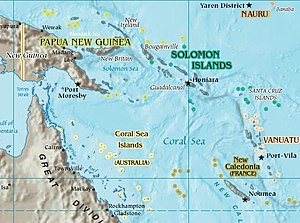Operation RY
| Operation RY | |
|---|---|
 Map of the Coral Sea area with Nauru and Ocean (Banaba) islands in the top right corner. | |
| Planned | April 1942 |
| Objective | Occupation of Nauru and Ocean islands |
| Date | 10 May to 30 August 1942 |
| Executed by | Imperial Japanese Navy |
| Outcome | Postponed on 15 May 1942; completed successfully on 29–30 August 1942 |
| Casualties | 1 minelayer, 1 auxiliary ship sunk |
This article needs additional citations for verification. (January 2023) |
Operation RY was the
Background
Nauru and Ocean Islands were isolated but rich
The
In late February 1942, as a Japanese invasion of Nauru and Ocean Island was feared, the
to evacuate both places. The ship arrived on 23 February and completed the evacuation without serious incident.Although
First invasion attempt
On 11 May 1942, the Imperial Japanese invasion force departed Rabaul, under the command of
While steaming through driving rain off New Ireland and west of Buka Island, Okinoshima, which had been damaged by airplanes from Yorktown during the invasion of Tulagi on 4 May 1942, was torpedoed at 04:52 by the United States Navy submarine S-42 (Commander Oliver G. Kirk) and severely damaged.[2][3] The invasion force's escorts closed S-42 and depth charged the area until 1130, causing damage. The submarine left the area to return to base at Moreton Bay, Brisbane. Rear Admiral Shima transferred his flag to Yūzuki southwest of Buka Island, Bougainville. At 06:40, Okinoshima capsized under tow by Mochizuki in St. George's Channel at 05°06′S 153°48′E / 5.100°S 153.800°E.
While returning to Rabaul after being dispatched to assist repair work on Okinoshima, the repair ship
.In spite of the loss of Okinoshima, the rest of the Japanese forces continued with the operation. As these forces were en route, however, a Japanese reconnaissance aircraft from Tulagi sighted the United States Navy aircraft carriers USS Enterprise and Hornet heading towards Nauru. The two US carriers, acting on intelligence obtained from intercepted Japanese communications, had been sent to the area as a feint to try to stop the Japanese operation.
The feint was successful. Fearing the threat posed by the US carriers to the RY forces, which did not have air cover, the Japanese cancelled the operation on 15 May, and the naval forces returned to Rabaul.
Second, successful attempt
A second invasion force departed Truk on 26 August 1942, consisting of the cruiser Yūbari, the destroyers Oite, Yūzuki, Ariake, Yūgure and Yūnagi, and the transport Hakozaki Maru.
The landing forces landed on Nauru on 29 August and Ocean Island on 30 August unopposed.
Occupation
Japanese forces occupied the two islands until the end of the war, but became increasingly isolated as the war progressed.
During the Japanese occupation of Nauru, American aircraft repeatedly bombed the island's facilities.
References
- ^ Bullard, p. 57.
- ^ "Battle of the Coral Sea". Naval History & Heritage. US Navy. Archived from the original on 24 June 2011. Retrieved 6 June 2011.
- ^ "USN Ships USS S-42 (SS-153)". NAVAL HISTORICAL CENTER. US Navy. Archived from the original on 14 February 2011. Retrieved 6 June 2011.
- ^ "USN Ships USS S-44 (SS-155)". NAVAL HISTORICAL CENTER. US Navy. Archived from the original on 18 September 2011. Retrieved 6 June 2011.
Books
- Brown, David (1990). Warship Losses of World War Two. Naval Institute Press. ISBN 1-55750-914-X.
- Lundstrom, John B. (2006). Black Shoe Carrier Admiral: Frank Jack Fletcher at Coral Sea, Midway, and Guadalcanal. Annapolis, Maryland: Naval Institute Press. ISBN 1-59114-475-2.
- Lundstrom, John B. (2005). The First Team: Pacific Naval Air Combat from Pearl Harbor to Midway (New ed.). Annapolis, Maryland, U.S.A.: Naval Institute Press. ISBN 1-59114-471-X.
- Willmott, H. P. (2002). The War with Japan: The Period of Balance, May 1942 – October 1943. ISBN 0-8420-5032-9.
Web
- Bullard, Steven (translator) (2007). Japanese army operations in the South Pacific Area New Britain and Papua campaigns, 1942–43. Canberra: Australian War Memorial. Senshi Sōshō)
- Hackett, Bob; Kingsepp, Sander (2003). "IJN Furutaka: Tabular Record of Movement". Junyokan. Combinedfleet.com. Retrieved 10 May 2009.
- Hackett, Bob, Sander Kingsepp, and Peter Cundall (1998–2007). "IJN Myoko: Tabular Record of Movement". Junyokan!. Combinedfleet.com.
{{cite web}}: CS1 maint: multiple names: authors list (link) - Hackett, Bob, and Sander Kingsepp (1998–2007). "IJN Minelayer Okinoshima: Tabular Record of Movement". Fusetsukan!. Combinedfleet.com.
{{cite web}}: CS1 maint: multiple names: authors list (link) - Hackett, Bob, Sander Kingsepp, and Peter Cundall (1998–2007). "IJN Tatsuta: Tabular Record of Movement". Junyokan!. Combinedfleet.com.
{{cite web}}: CS1 maint: multiple names: authors list (link) - Hackett, Bob, Sander Kingsepp, and Peter Cundall (1998–2007). "IJN Tsugaru: Tabular Record of Movement". Fusetsukan!. Combinedfleet.com.
{{cite web}}: CS1 maint: multiple names: authors list (link) - McCarthy, Dudley (1959). Volume V – South–West Pacific Area – First Year: Kokoda to Wau. Australia in the War of 1939–1945, Series 1: Army. Canberra: Australian War Memorial. Archived from the original on 25 May 2009. Retrieved 2 November 2006.
- Nevitt, Allyn D. (1998–2009). "IJN Uzuki: Tabular Record of Movement". Long Lancers!. Combinedfleet.com.
